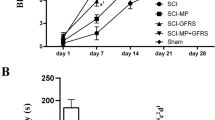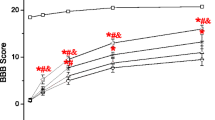Abstract
The study was performed to investigate the effect of combination therapy with aminoguanidine (AG) and dexamethasone (DEX) on the compression spinal cord injury (SCI) in rat. Compared to the control group, the combination therapy group with AG (75 mg/kg) and DEX (0.025 mg/kg) significantly reduced the degree of (1) spinal cord edema, (2) the permeability of blood spinal cord barrier (measured by 99mTc-Albumin), (3) infiltration of neutrophils (MPO evaluation), (4) cytokines expression (tumor necrosis factor-α and interleukin-1β), and (5) apoptosis (measured by Bax and Bcl-2 expression). In addition, we have also clearly demonstrated that the combination therapy significantly ameliorated the recovery of limb function (evaluated by motor recovery score). Taken together, our results clearly indicated for the first time that strategies targeting multiple proinflammatory pathways may be more effective than a single effector molecule for the treatment of SCI.






Similar content being viewed by others
References
Abdel-Rahman E, Bolto WK (2002) Pimagedin: a novel therapy for diabetic nephropathy. Expert Opin Investig Drug 11:565–574. doi:10.1517/13543784.11.4.565
Barbany G, Persson H (1992) Regulation of neurotrophin mRNA expression in the rat brain by glucocorticoids. Eur J NeuroSci 4:396–403. doi:10.1111/j.1460-9568.1992.tb00888.x
Basso DM, Beattie MS, Bresnahan JC (1995) A sensitive and reliable locomotor rating scale for open field testing in rats. J Neurotrauma 12:1–21. doi:10.1089/neu.1995.12.1
Caldenhoven E, Liden J, Wissink S, Van de Stolpe A, Raaijmakers J, Koenderman L, Okret S, Gustafsson JA, Van der Saag PT (1995) Negative cross-talk between RelA and the glucocorticoid receptor: a possible mechanism for the antiinflammatory action of glucocorticoids. Mol Endocrinol 9:401–412. doi:10.1210/me.9.4.401
Campbell IL (1996) Exacerbation of lymphocytic choriomeningitis in mice treated with the inducible nitric oxide synthase inhibitor aminoguanidine. J Neuroimmunol 71:31–36. doi:10.1016/S0165-5728(96)00129-4
Cash D, Beech JS, Rayne RC, Bath PM, Meldrum BS, Williams SC (2001) Neuroprotective effect of aminoguanidine on transient focal ischaemia in the rat brain. Brain Res 29:91–103. doi:10.1016/S0006-8993(01)02508-2
Fan D, Gu YT, Lv H, Tang T, Xu ZH, Shi XY, Xue HL, Wang YJ (2008) Role of aminoguanidine in brain protection in surgical brain injury in rat. Neurosci Lett 448(2):204–207. doi:10.1016/j.neulet.2008.10.038
Garbuzova-Davis S, Haller E, Saporta S, Kolomey I, Nicosia SV, Sanberg PR (2007) Ultrastructure of blood-brain barrier and blood-spinal cord barrier in SOD1 mice modeling ALS. Brain Res 1157:126–137
Genovese T, Mazzon E, Crisafulli C, Di Paola R, Muia C, Bramanti P, Cuzzocrea S (2006) Immunomodulatory effects of etanercept in an experimental model of spinal cord injury. J Pharmacol Exp Ther 316:1006–1016. doi:10.1124/jpet.105.097188
Giardino I, Fard AK, Hatchell DL, Brownlee M (1998) Aminoguanidine inhibits reactive oxygen species formation, lipid peroxidation, and oxidant-induced apoptosis. Diabetes 47:1114–1120. doi:10.2337/diabetes.47.7.1114
Gonzalez Deniselle MC, Gonzalez S, Piroli G, Ferrini M, Lima AE, De Nicola AF (1997) Glucocorticoid receptors and actions in the spinal cord of the wobbler mouse, a model for neurodegenerative diseases. J Steroid Biochem Mol Biol 60:205–213. doi:10.1016/S0960-0760(96)00193-8
Gonzalez R, Glaser J, Liu MT, Lane TE, Keirstead HS (2003) Reducing inflammation decreases secondary degeneration and functional deficit after spinal cord injury. Exp Neurol 184:456–463. doi:10.1016/S0014-4886(03)00257-7
Huang WL, George KJ, Ibba V, Liu MC, Averill S, Quartu M et al. (2007) The characteristics of neuronal injury in a static compression model of spinal cord injury in adult rats. Eur J Neurol 25:362–372
Hurlbert RJ (2006) Strategies of medical intervention in the management of acute spinal cord injury. Spine 31:S16–S21. doi:10.1097/01.brs.0000218264.37914.2c
Joshi M, Fehlings MG (2002) Development and characterization of a novel, graded model of clip compressive spinal cord injury in the mouse: Part 2. Quantitative neuroanatomical assessment and analysis of the relationships between axonal tracts, residual tissue, and locomotor recovery. J Neurotrauma 19:191–203
Kazachkov M, Chen K, Babiy S, Yu PH (2007) Evidence for in vivo scavenging by aminoguanidine of formaldehyde produced via SSAO-mediated deamination. J Pharmacol Exp Ther 322:1201–1207. doi:10.1124/jpet.107.124123
Louin G, Marchand-Verrecchia C, Palmier B, Plotkine M, Jafarian-Tehrani M (2006) Selective inhibition of inducible nitric oxide synthase reduces neurological deficit but not cerebral edema following traumatic brain injury. Neuropharmacology 50:182–190. doi:10.1016/j.neuropharm.2005.08.020
Lu B, Wang L, Stehlik C et al. (2006) Phosphatidylinositol 3-kinase/Akt positively regulates Fas (CD95)-mediated apoptosis in epidermal Cl41 cells. J Immunol 176:6785–6793
Machuca C, Mendoza-Milla C, Cordova E, Mejia S, Covarrubias L, Ventura J, Zentella A (2006) Dexamethasone protection from TNFalpha-induced cell death in MCF-7 cells requires NF-kappaB and is independent from AKT. BMC Cell Biol 7:9. doi:10.1186/1471-2121-7-9
Maeda K, Yoshida K, Ichimiya I, Suzuki M (2005) Dexamethasone inhibits tumor necrosis factor-alpha-induced cytokine secretion from spiral ligament fibrocytes. Hear Res 202:154–160. doi:10.1016/j.heares.2004.08.022
Marlier LN, Csikos T, Rebaudengo N, Borboni P, Patacchioli FR, Angelucci L, Privat A, Lauro R (1995) Distribution of glucocorticoid receptor mRNA in the rat spinal cord. NeuroReport 6:2245–2249. doi:10.1097/00001756-199511000-00034
McTigue DM, Tani M, Krivacic K et al. (1998) Selective chemokine mRNA accumulation in the rat spinal cord after contusion injury. J Neurosci Res 53:368–376
Mullane K (1989) Neutrophil-platelet interactions and post-ischemic myocardial injury. Prog Clin Biol Res 301:39–51
Pearse DD, Chatzipanteli K, Marcillo AE, Bunge MB, Dietrich WD (2003) Comparison of iNOS inhibition by antisense and pharmacological inhibitors after spinal cord injury. J Neuropathol Exp Neurol 62:1096–1107
Pineau I, Lacroix S (2007) Proinflammatory cytokine synthesis in the injured mouse spinal cord: multiphasic expression pattern and identification of the cell types involved. J Comp Neurol 500:267–285. doi:10.1002/cne.21149
Sharma HS, Sjöquist PO, Mohanty S, Wiklund L (2006) Post-injury treatment with a new antioxidant compound H-290/51 attenuates spinal cord trauma-induced c-fos expression, motor dysfunction, edema formation, and cell injury in the rat. Acta Neurochir Suppl (Wien) 96:322–328. doi:10.1007/3-211-30714-1_68
Streit WJ, Semple-Rowland SL, Hurley SD, Miller RC, Popovich PG, Stokes BT (1998) Cytokine mRNA profiles in contused spinal cord and axotomized facial nucleus suggest a beneficial role for inflammation and gliosis. Exp Neurol 152:74–87. doi:10.1006/exnr.1998.6835
Sugimoto K, Iadecola C (2002) Effects of aminoguanidine on cerebral ischemia in mice: comparison between mice with and without inducible nitric oxide synthase gene. Neurosci Lett 331:25–28. doi:10.1016/S0304-3940(02)00834-0
Wang S, Lim G, Zeng Q, Sung B, Yang L, Mao J (2005) Central glucocorticoid receptors modulate the expression and function of spinal NMDA receptors after peripheral nerve injury. J Neurosci 25:488–495. doi:10.1523/JNEUROSCI.4127-04.2005
Wu CH, Ding XY, Wang HY, Ye XB, Huang SY, Huang AM, Li HZ, Wu SY, Yu J, Yan XH (2006) Neural apoptosis and apoptosis-related genes in intracerebral hemorrhage patients. Zhonghua Yi Xue Za Zhi 86:3073–3076
Zhang XY, Zhou CS, Jin AM, Tian J, Zhang H, Yao WT, Zheng G (2003) Effect of aminoguanidine on the recovery of rat hindlimb motor function after spinal cord injury. Di Yi Jun Yi Da Xue Xue Bao 23:687–689
Acknowledgments
This work was supported by Special fund for scientific research of postdoctoral subjects in China, No. 20060400292, Natural Science Foundation of Liaoning Province in China, No. 20082207 and Special fund for scientific research of doctoral subjects in Liaoning Province in China, No. 20081052.
Author information
Authors and Affiliations
Corresponding author
Rights and permissions
About this article
Cite this article
Xu, Wb., Lv, G., Wang, Yf. et al. Combination of Dexamethasone and Aminoguanidine Reduces Secondary Damage in Compression Spinal Cord Injury. Cell Mol Neurobiol 29, 683–689 (2009). https://doi.org/10.1007/s10571-009-9380-8
Received:
Accepted:
Published:
Issue Date:
DOI: https://doi.org/10.1007/s10571-009-9380-8




